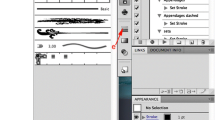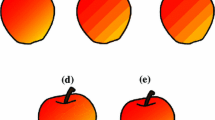Abstract
Silhouettes are building elements of logos, graphic symbols and fonts. These shapes can be designed and exchanged in vector form, but more often they are drawn, printed, scanned, or directly found in digital images. Such raster forms require vectorization to get scale-invariant exchangeable formats. There is a need for a mathematically well-defined and justified shape vectorization process, which also provides a minimal set of control points with geometric meaning. In this paper, we propose a new silhouette vectorization paradigm. It extracts the outline of a 2D shape from a raster binary image and converts it to a combination of cubic Bézier polygons and perfect circles. The proposed method uses the sub-pixel curvature extrema and affine scale-space for silhouette vectorization. By construction, our control points are geometrically stable under affine transformations. The proposed method can also be used as a reliable feature point detector for silhouettes. Compared to state-of-the-art image vectorization software, our algorithm demonstrates a superior reduction in the number of control points while maintaining high accuracy.









Similar content being viewed by others
Notes
See (e.g.) https://en.wikipedia.org/wiki/Adobe_Illustrator or Vector Magic.
References
Adobe Illustrator. https://www.adobe.com/products/illustrator.html
Inkscape. https://inkscape.org
SVG SILH. https://svgsilh.com. All contents are released under Creative Commons CC0
Vector Magic. https://vectormagic.com
Alvarez, L.: Corner detection using the affine morphological scale space. In: International Conference on Scale Space and Variational Methods in Computer Vision, pp. 29–40. Springer (2017)
Álvarez, L., Guichard, F., Lions, P.L., Morel, J.M.: Axiomes et équations fondamentales du traitement d’images.(analyse multiéchelle et edp). Comptes rendus de l’Académie des sciences. Série 1, Mathématique 315(2), 135–138 (1992)
Alvarez, L., Morales, F.: Affine morphological multiscale analysis of corners and multiple junctions. International Journal of Computer Vision 25(2), 95–107 (1997)
Alvarez, L., Morel, J.M.: Formalization and computational aspects of image analysis. Acta numerica 3, 1–59 (1994)
Ambrosio, L., Caselles, V., Masnou, S., Morel, J.M.: Connected components of sets of finite perimeter and applications to image processing. Journal of the European Mathematical Society 3(1), 39–92 (2001)
Andrew, A.: Another efficient algorithm for convex hulls in two dimensions. Information Processing Letters 9(5), 216–219 (1979)
Attneave, F.: Some informational aspects of visual perception. Psychological review 61(3), 183 (1954)
Balarini, J.P., Nesmachnow, S.: A C++ Implementation of Otsu’s Image Segmentation Method. Image Processing On Line 6, 155–164 (2016). https://doi.org/10.5201/ipol.2016.158
Bay, H., Tuytelaars, T., Van Gool, L.: Surf: Speeded up robust features. In: European conference on computer vision, pp. 404–417. Springer (2006)
Cao, F.: Geometric curve evolution and image processing. Springer Science & Business Media (2003)
Cao, F., Lisani, J.L., Morel, J.M., Musé, P., Sur, F.: A theory of shape identification. Springer Science & Business Media (2008)
Caselles, V., Monasse, P.: Geometric description of images as topographic maps. Springer (2009)
Chang, H.H., Yan, H.: Vectorization of hand-drawn image using piecewise cubic bezier curves fitting. Pattern recognition 31(11), 1747–1755 (1998)
Chetverikov, D.: A simple and efficient algorithm for detection of high curvature points in planar curves. In: International Conference on Computer Analysis of Images and Patterns, pp. 746–753. Springer (2003)
Cinque, L., Levialdi, S., Malizia, A.: Shape description using cubic polynomial bezier curves. Pattern Recognition Letters 19(9), 821–828 (1998)
Ciomaga, A., Monasse, P., Morel, J.M.: Level lines shortening yields an image curvature microscope. In: 2010 IEEE International Conference on Image Processing, pp. 4129–4132. IEEE (2010)
Ciomaga, A., Monasse, P., Morel, J.M.: The image curvature microscope: Accurate curvature computation at subpixel resolution. Image Processing On Line 7, 197–217 (2017)
Goldapp, M.: Approximation of circular arcs by cubic polynomials. Computer Aided Geometric Design 8(3), 227–238 (1991)
Harris, C.G., Stephens, M., et al.: A combined corner and edge detector. In: Alvey vision conference, vol. 15, pp. 10–5244. Citeseer (1988)
Iijima, T.: Basis theory on the normalization of two-dimensionalvisual pattern, studies on information and control, pattern recognition issue. IEICE Japan 1,(1963)
Kirsanov, A., Vavilin, A., Jo, K.: Contour-based algorithm for vectorization of satellite images. In: International Forum on Strategic Technology 2010, pp. 241–245. IEEE (2010)
Lowe, D.G.: Object recognition from local scale-invariant features. In: Proceedings of the seventh IEEE international conference on computer vision, vol. 2, pp. 1150–1157. Ieee (1999)
Matas, J., Chum, O., Urban, M., Pajdla, T.: Robust wide-baseline stereo from maximally stable extremal regions. Image and vision computing 22(10), 761–767 (2004)
Matheron, G.: Random sets and integral geometry [by] G. Matheron. Wiley, New York (1974)
Moisan, L.: Affine plane curve evolution: A fully consistent scheme. IEEE Transactions on Image Processing 7(3), 411–420 (1998)
Monasse, P., Guichard, F.: Scale-space from a level lines tree. Journal of Visual Communication and Image Representation 11(2), 224–236 (2000)
Montanari, U.: A note on minimal length polygonal approximation to a digitized contour. Communications of the ACM 13(1), 41–47 (1970)
Montero, A.S., Lang, J.: Skeleton pruning by contour approximation and the integer medial axis transform. Computers & Graphics 36(5), 477–487 (2012)
Morel, J.M., Yu, G.: Asift: A new framework for fully affine invariant image comparison. SIAM journal on imaging sciences 2(2), 438–469 (2009)
Mortenson, M.E.: Mathematics for computer graphics applications. Industrial Press Inc. (1999)
Nadal, C., Legault, R., Suen, C.Y.: Complementary algorithms for the recognition of totally unconstrained handwritten numerals. In: [1990] Proceedings. 10th International Conference on Pattern Recognition, vol. 1, pp. 443–449. IEEE (1990)
Pal, S., Ganguly, P., Biswas, P.: Cubic bézier approximation of a digitized curve. Pattern recognition 40(10), 2730–2741 (2007)
Pan, W., Lian, Z., Tang, Y., Xiao, J.: Skeleton-guided vectorization of chinese calligraphy images. In: 2014 IEEE 16th International Workshop on Multimedia Signal Processing (MMSP), pp. 1–6. IEEE (2014)
Plass, M., Stone, M.: Curve-fitting with piecewise parametric cubics. In: Proceedings of the 10th annual conference on Computer graphics and interactive techniques, pp. 229–239 (1983)
Preparata, F.P., Shamos, M.I.: Computational geometry: an introduction. Springer Science & Business Media (2012)
Ramer, U.: An iterative procedure for the polygonal approximation of plane curves. Computer graphics and image processing 1(3), 244–256 (1972)
Rosten, E., Drummond, T.: Fusing points and lines for high performance tracking. In: Tenth IEEE International Conference on Computer Vision (ICCV’05) Volume 1, vol. 2, pp. 1508–1515. Ieee (2005)
Sapiro, G., Tannenbaum, A.: Affine invariant scale-space. International journal of computer vision 11(1), 25–44 (1993)
Sarfraz, M.: Vectorizing outlines of generic shapes by cubic spline using simulated annealing. International Journal of Computer Mathematics 87(8), 1736–1751 (2010)
Schmid, C., Mohr, R., Bauckhage, C.: Evaluation of interest point detectors. International Journal of computer vision 37(2), 151–172 (2000)
Sorensen, T.A.: A method of establishing groups of equal amplitude in plant sociology based on similarity of species content and its application to analyses of the vegetation on danish commons. Biol. Skar. 5, 1–34 (1948)
Tombre, K., Tabbone, S.: Vectorization in graphics recognition: to thin or not to thin. In: Proceedings 15th International Conference on Pattern Recognition. ICPR-2000, vol. 2, pp. 91–96. IEEE (2000)
Weickert, J., Ishikawa, S., Imiya, A.: Linear scale-space has first been proposed in japan. Journal of Mathematical Imaging and Vision 10(3), 237–252 (1999)
Witkin, A.P.: Scale-space filtering. In: Readings in Computer Vision, pp. 329–332. Elsevier (1987)
Yang, H.M., Lu, J.J., Lee, H.J.: A bezier curve-based approach to shape description for chinese calligraphy characters. In: Proceedings of Sixth International Conference on Document Analysis and Recognition, pp. 276–280. IEEE (2001)
Zou, J.J., Yan, H.: Cartoon image vectorization based on shape subdivision. In: Proceedings. Computer Graphics International 2001, pp. 225–231. IEEE (2001)
Author information
Authors and Affiliations
Corresponding author
Additional information
Publisher's Note
Springer Nature remains neutral with regard to jurisdictional claims in published maps and institutional affiliations.
Yuchen He is supported in part by Chateaubriand Fellowship, Embassy of France in United States. Sung Ha Kang is supported in part by Simons Foundation Grant 584960. Jean-Michel Morel is supported by Fondation Mathématique Jacques Hadamard.
The algorithm introduced in this paper can be tested online on any image at https://ipolcore.ipol.im/demo/clientApp/demo.html?id=5555531082020.
Appendices
Silhouette Data Set
In Table 3, we collectively display the 20 silhouettes used in this paper. They are all downloadable from https://svgsilh.com, which are released under Creative Commons CC0.
Pseudocode for the Proposed Method
Here we present the pseudocode for our proposed method. In the description, we assume that the specified bilinear level set consists of only one Jordan curve for simplicity. In practice, the level set may contain multiple Jordan curves or self-crossing curves. If self-crossing occurs, we trace along the direction given by the level line at \(\lambda ^*+l\) for \(l>0\) sufficiently small [21]. Hence, it suffices to process each Jordan curve of the level set independently via the described algorithm.
Rights and permissions
About this article
Cite this article
He, Y., Kang, S.H. & Morel, JM. Silhouette Vectorization by Affine Scale-Space. J Math Imaging Vis 64, 41–56 (2022). https://doi.org/10.1007/s10851-021-01053-z
Received:
Accepted:
Published:
Issue Date:
DOI: https://doi.org/10.1007/s10851-021-01053-z




